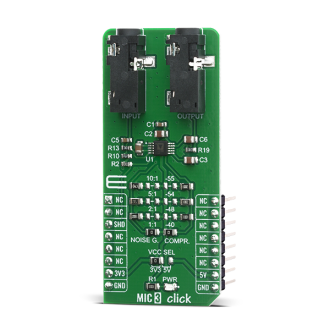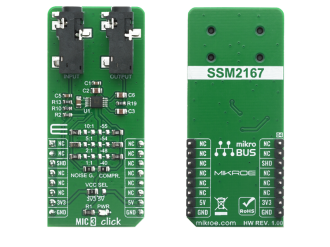
We strongly encourage users to use Package manager for sharing their code on Libstock website, because it boosts your efficiency and leaves the end user with no room for error. [more info]

Rating:
Author: MIKROE
Last Updated: 2020-06-10
Package Version: 1.0.0.0
mikroSDK Library: 1.0.0.0
Category: Microphone
Downloaded: 1877 times
Not followed.
License: MIT license
The MIC 3 Click is a Click board that features the SSM2167-1RMZ-R7, a Microphone Preamplifier, from Analog Device.The Click board is a low voltage Microphone preamplifier with Variable compression and noise gating.
Do you want to subscribe in order to receive notifications regarding "MIC 3 click" changes.
Do you want to unsubscribe in order to stop receiving notifications regarding "MIC 3 click" changes.
Do you want to report abuse regarding "MIC 3 click".


Library Description
Library provides function for setting state of the pin, and function for GPIO mapping.
Key functions:
void mic3_set_shd_pin ( uint8_t state ) - Function for setting shd pin stateExamples description
The application is composed of three sections :
void application_init ( )
{
mikrobus_logWrite( " ***** APP INIT ***** ", _LOG_LINE );
mic3_gpio_driver_init( (mic3_obj_t)&_MIKROBUS1_GPIO );
mic3_set_shd_pin( MIC3_PIN_STATE_HIGH );
mikrobus_logWrite( " ***** APP TASK ***** ", _LOG_LINE );
mikrobus_logWrite( " - Microphone is turned on - ", _LOG_LINE );
}
Other mikroE Libraries used in the example:
Additional notes and informations
Depending on the development board you are using, you may need USB UART click, USB UART 2 click or RS232 click to connect to your PC, for development systems with no UART to USB interface available on the board. The terminal available in all MikroElektronika compilers, or any other terminal application of your choice, can be used to read the message.